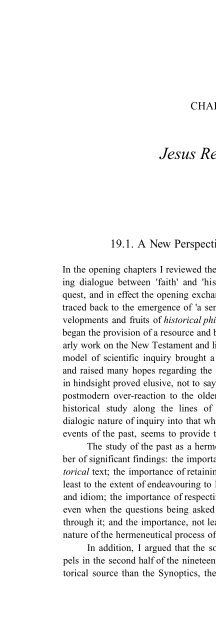Jesus Remembered: Christianity in the Making, vol. 1
Jesus Remembered: Christianity in the Making, vol. 1 Jesus Remembered: Christianity in the Making, vol. 1
CHAPTER 19 Jesus Remembered 19.1. A New Perspective on the Jesus Tradition In the opening chapters I reviewed the 'quest of the historical Jesus' as an ongoing dialogue between 'faith' and 'history'. I pointed out that the roots of this quest, and in effect the opening exchanges of the contemporary dialogue, can be traced back to the emergence of 'a sense of history' in the Renaissance. The developments and fruits of historical philology and textual criticism from that time began the provision of a resource and base which is still fundamental to all scholarly work on the New Testament and life of Jesus research. The emergence of the model of scientific inquiry brought a rigorous methodology to historical study and raised many hopes regarding the objectivity of historical 'facts' which have in hindsight proved elusive, not to say illusory. But there is an equal danger of a postmodern over-reaction to the older historicist over-confidence. A model for historical study along the lines of 'critical realism', which recognizes the dialogic nature of inquiry into that which may be known concerning persons and events of the past, seems to provide the most promising way forward. The study of the past as a hermeneutical problem also highlighted a number of significant findings: the importance of recognizing a historical text as historical text; the importance of retaining an active concept of 'plain meaning', at least to the extent of endeavouring to listen to the text speak in its own language and idiom; the importance of respecting the intention of the text (entextualized), even when the questions being asked seek to draw other information from it or through it; and the importance, not least, of acknowledging and allowing for the nature of the hermeneutical process of dialogue between text and hearer/reader. In addition, I argued that the source-critical findings of study of the Gospels in the second half of the nineteenth century (John as a much less direct historical source than the Synoptics, the two-source hypothesis for the Synoptics) 881
- Page 1750: §18.3 Et Resurrexit Despite uncert
- Page 1754: §18.4 Et Resurrexit himself. It is
- Page 1758: §18.4 Et Resurrexit (1) A key elem
- Page 1762: §18.4 Et Resurrexit memories of wh
- Page 1766: §18.4 Et Resurrexit is given pride
- Page 1770: §18.4 Et Resurrexit pearance and t
- Page 1774: §18.5 Et Resurrexit regarding thei
- Page 1778: §18.5 EtResurrexit (i) One of the
- Page 1782: §18.5 Et Resurrexit Paul believed
- Page 1786: §18.5 Et Re surr exit saw was give
- Page 1790: §18.5 Et Resurrexit interpretation
- Page 1794: §18.6 Et Resurrexit tween event, d
- Page 1798: §18.6 Et Resurrexit move any idea
- Page 1806: §19.1 Jesus Remembered pact. Any o
- Page 1810: §19.2 Jesus Remembered We started
- Page 1814: §19.2 Jesus Remembered ing in God
- Page 1818: §19.2 Jesus Remembered ously made
- Page 1822: §19.3 Jesus Remembered pute that t
- Page 1826: §19.3 Jesus Remembered ing and con
- Page 1832: ABBREVIATIONS BDB F. Brown, S. R. D
- Page 1836: ABBREVIATIONS JJS Journal of Jewish
- Page 1840: ABBREVIATIONS ST Studia Theologica
- Page 1844: BIBLIOGRAPHY . The End of the Ages
- Page 1848: BIBLIOGRAPHY Barth, K. From Roussea
CHAPTER 19<br />
<strong>Jesus</strong> <strong>Remembered</strong><br />
19.1. A New Perspective on <strong>the</strong> <strong>Jesus</strong> Tradition<br />
In <strong>the</strong> open<strong>in</strong>g chapters I reviewed <strong>the</strong> 'quest of <strong>the</strong> historical <strong>Jesus</strong>' as an ongo<strong>in</strong>g<br />
dialogue between 'faith' and 'history'. I po<strong>in</strong>ted out that <strong>the</strong> roots of this<br />
quest, and <strong>in</strong> effect <strong>the</strong> open<strong>in</strong>g exchanges of <strong>the</strong> contemporary dialogue, can be<br />
traced back to <strong>the</strong> emergence of 'a sense of history' <strong>in</strong> <strong>the</strong> Renaissance. The developments<br />
and fruits of historical philology and textual criticism from that time<br />
began <strong>the</strong> provision of a resource and base which is still fundamental to all scholarly<br />
work on <strong>the</strong> New Testament and life of <strong>Jesus</strong> research. The emergence of <strong>the</strong><br />
model of scientific <strong>in</strong>quiry brought a rigorous methodology to historical study<br />
and raised many hopes regard<strong>in</strong>g <strong>the</strong> objectivity of historical 'facts' which have<br />
<strong>in</strong> h<strong>in</strong>dsight proved elusive, not to say illusory. But <strong>the</strong>re is an equal danger of a<br />
postmodern over-reaction to <strong>the</strong> older historicist over-confidence. A model for<br />
historical study along <strong>the</strong> l<strong>in</strong>es of 'critical realism', which recognizes <strong>the</strong><br />
dialogic nature of <strong>in</strong>quiry <strong>in</strong>to that which may be known concern<strong>in</strong>g persons and<br />
events of <strong>the</strong> past, seems to provide <strong>the</strong> most promis<strong>in</strong>g way forward.<br />
The study of <strong>the</strong> past as a hermeneutical problem also highlighted a number<br />
of significant f<strong>in</strong>d<strong>in</strong>gs: <strong>the</strong> importance of recogniz<strong>in</strong>g a historical text as historical<br />
text; <strong>the</strong> importance of reta<strong>in</strong><strong>in</strong>g an active concept of 'pla<strong>in</strong> mean<strong>in</strong>g', at<br />
least to <strong>the</strong> extent of endeavour<strong>in</strong>g to listen to <strong>the</strong> text speak <strong>in</strong> its own language<br />
and idiom; <strong>the</strong> importance of respect<strong>in</strong>g <strong>the</strong> <strong>in</strong>tention of <strong>the</strong> text (entextualized),<br />
even when <strong>the</strong> questions be<strong>in</strong>g asked seek to draw o<strong>the</strong>r <strong>in</strong>formation from it or<br />
through it; and <strong>the</strong> importance, not least, of acknowledg<strong>in</strong>g and allow<strong>in</strong>g for <strong>the</strong><br />
nature of <strong>the</strong> hermeneutical process of dialogue between text and hearer/reader.<br />
In addition, I argued that <strong>the</strong> source-critical f<strong>in</strong>d<strong>in</strong>gs of study of <strong>the</strong> Gospels<br />
<strong>in</strong> <strong>the</strong> second half of <strong>the</strong> n<strong>in</strong>eteenth century (John as a much less direct historical<br />
source than <strong>the</strong> Synoptics, <strong>the</strong> two-source hypo<strong>the</strong>sis for <strong>the</strong> Synoptics)<br />
881



